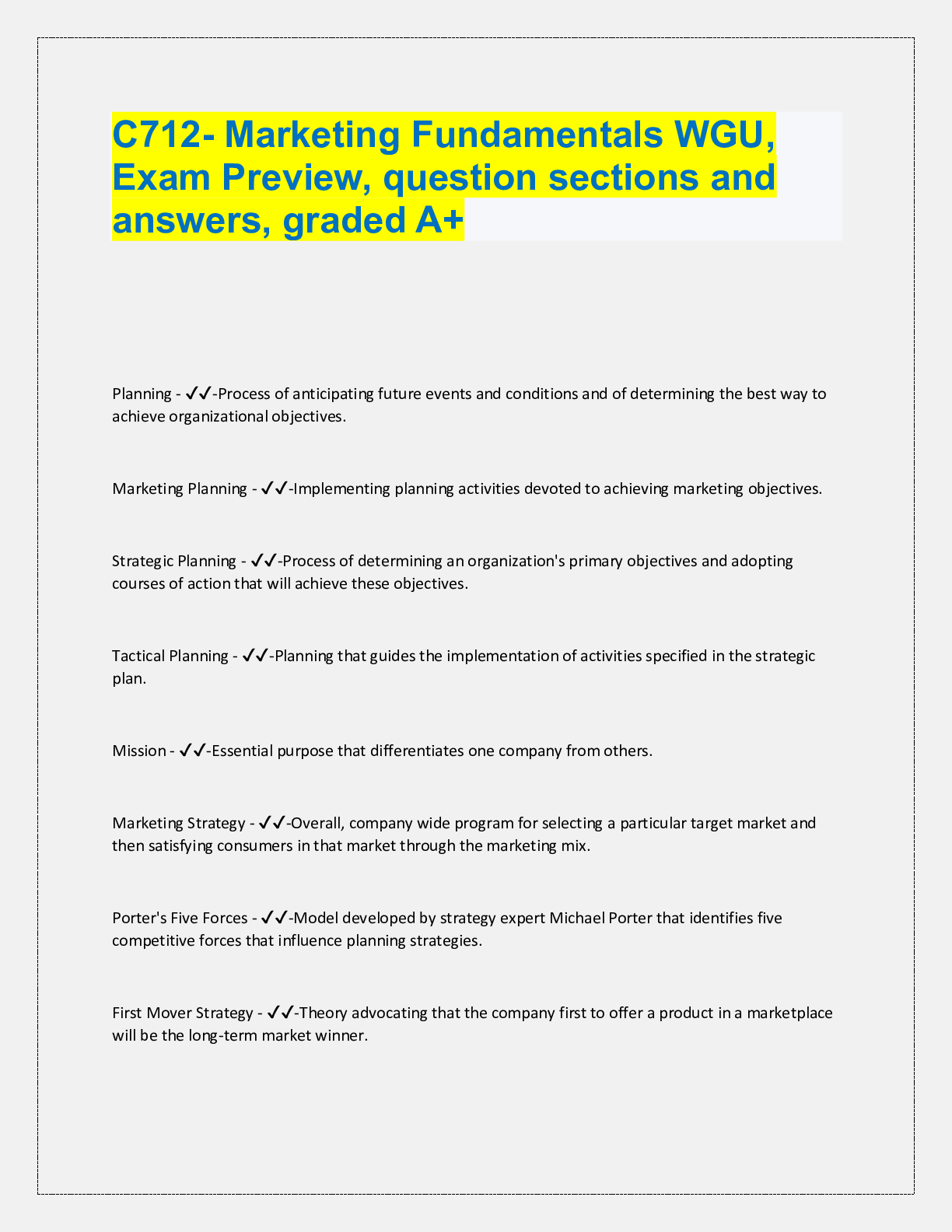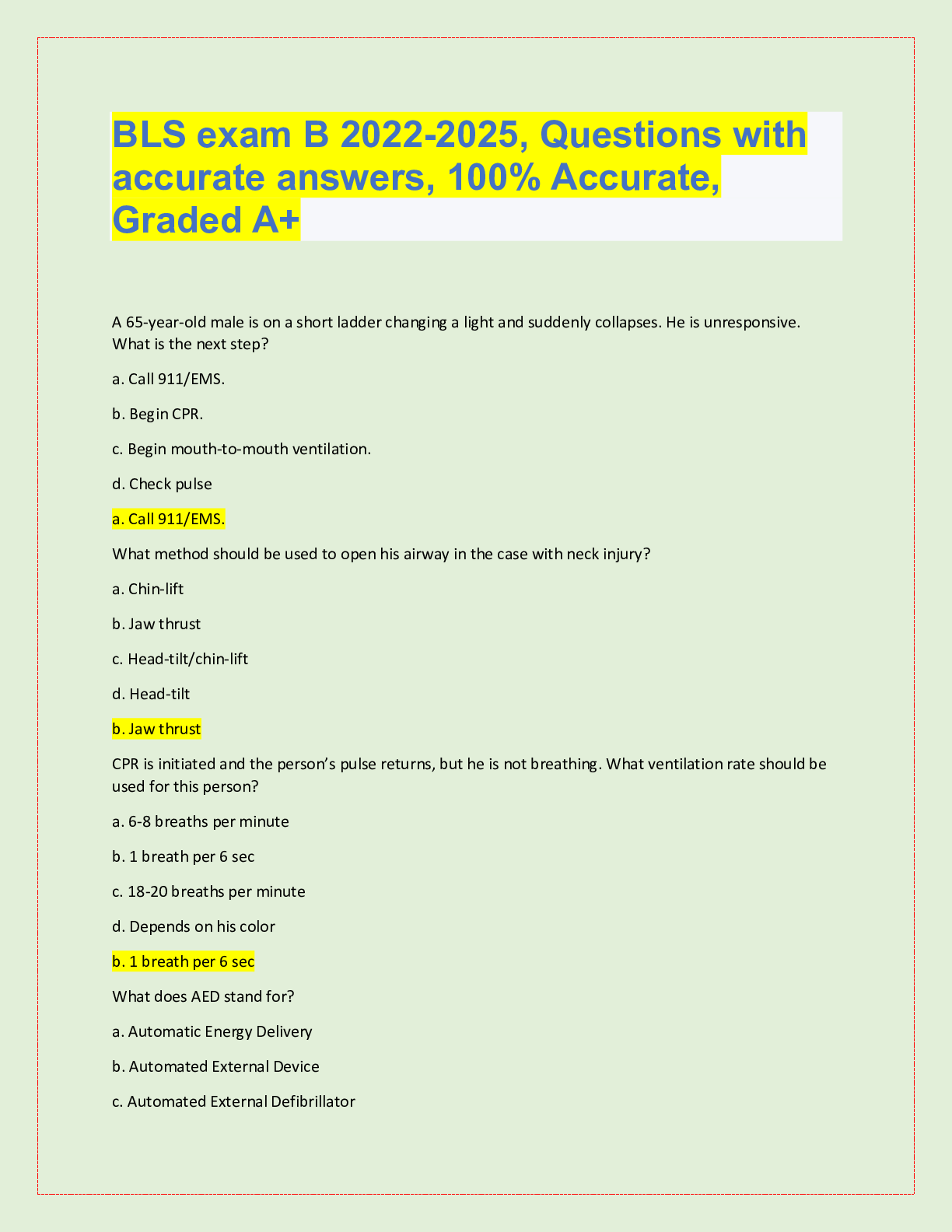Marketing > QUESTIONS & ANSWERS > C712- Marketing Fundamentals WGU. Exam Questions with accurate answers, rated A (All)
C712- Marketing Fundamentals WGU. Exam Questions with accurate answers, rated A
Document Content and Description Below
C712- Marketing Fundamentals WGU. Exam Questions with accurate answers, rated A Planning - Process of anticipating future events and conditions and of determining the best way to achieve organi... zational objectives. Marketing Planning - Implementing planning activities devoted to achieving marketing objectives. Strategic Planning - Process of determining an organization's primary objectives and adopting courses of action that will achieve these objectives. Tactical Planning - Planning that guides the implementation of activities specified in the strategic plan. Mission - Essential purpose that differentiates one company from others. Marketing Strategy - Overall, company wide program for selecting a particular target market and then satisfying consumers in that market through the marketing mix. Porter's Five Forces - Model developed by strategy expert Michael Porter that identifies five competitive forces that influence planning strategies. First Mover Strategy - Theory advocating that the company first to offer a product in a marketplace will be the long-term market winner. Second Mover Strategy - Theory that advocates observing closely the innovations of first movers and then improving on them to gain advantage in the marketplace. SWOT Analysis - Review that helps planners compare internal organizational strengths and weaknesses with external opportunities and threats. Strategic Window - Limited periods when key requirements of a market and a firm's particular competencies best fit together. Marketing Mix - Blending of the four strategy elements—product, distribution, promotion, and pricing— to fit the needs and preferences of a specific target market. strategic business units (SBUs) - Key business units within diversified firms. Environmental scanning - Systematic study of the components of a purchase to determine the most cost-effective approach. Environmental Management - Assessment of supplier performance in categories such as price, back orders, timely delivery, and attention to special requests. Strategic Alliance - Partnership in which two or more companies combine resources and capital to create competitive advantages in a new market. competitive environment - Interactive process that occurs in the marketplace among marketers of directly competitive products, marketers of products that can be substituted for one another, and marketers competing for the consumer's purchasing power. Monopoly - Market structure in which a single seller dominates trade in a good or service for which buyers can find no close substitutes. Antitrust - Laws designed to prevent restraints on trade such as business monopolies. oligopoly - Market structure in which relatively few sellers compete and where high start-up costs form barriers to keep out new competitors. Competitive Strategy - Methods through which a firm deals with its competitive environment. Time Based Competitition - Strategy of developing and distributing goods and services more quickly than competitors. political-legal environment - Component of the marketing environment consisting of laws and their interpretations that require firms to operate under competitive conditions and to protect consumer rights. Gross Domestic Product (GDP) - Sum of all goods and services produced by a nation in a year. Economic Environment - Factors that influence consumer buying power and marketing strategies, including stage of the business cycle, inflation and deflation, unemployment, income, and resource availability. Business Cycle - Pattern of stages in the level of economic activity: prosperity, recession, depression, and recovery. Inflation - Rising prices caused by some combination of excess consumer demand and increases in the costs of one or more factors of production. Unemployment - Proportion of people in the economy actively seeking work that do not have jobs. Discretionary Income - Money available to spend after buying necessities such as food, clothing, and housing. Demarketing - Process of reducing consumer demand for a good or service to a level that the firm can supply. Technology Environment - Application to marketing of knowledge based on discoveries in science, inventions, and innovations. VoIP (Voice over Internet Protocol) - A phone connection through a personal computer with any type of broadband Internet connection. Social-Culture Environment - Component of the marketing environment consisting of the relationship between the marketer, society, and culture. Consumerism - Social force within the environment that aids and protects the consumer by exerting legal, moral, and economic pressures on business and government. Consumer Rights - List of legitimate consumer expectations suggested by President John F. Kennedy. Marketing - The activity, set of institutions, and processes for creating, communicating, delivering, and exchanging offerings that have value for customers, clients, partners, and society at large. Wholesalers - Intermediaries that operate between producers and resellers. Exchange Functions - Buying and selling. Social Media - Different forms of electronic communication through which users can create online communities to exchange information, ideas, messages, and other content, such as videos or music. Social Media Platform - A type of software or technology that allows users to build, integrate, or facilitate a community, interaction among users, and user-generated content. Social Media Tool - Software (such as an app or blog) that enables users to communicate with each other online. Social-Networking sites - A website that provides virtual communities through which people can share information, post opinions, and increase their circle of online friends. Bookmarking - A platform that gives users a place to save, organize, and manage links to websites and other Internet resources. Social News Site - A platform where users can post news items to links to outside articles, then vote on which postings get the most prominent display. Online forums - A platform where users post messages and hold conversations on specified topics. Blogging Sites - A platform where a host or writer posts information or opinions on various topics and followers may respond. Microblogs - A blog posting that contains only a few words (such as on Twitter). App - Short for application, a free or purchased software download that links users to a wide range of goods and services, media and text content, social media platforms, search engines, and the like. QR Codes - Short for "quick response," a two-dimensional barcode that can be read by some mobile phones with cameras. Social Media Marketing (SMM) - The use of social media portals to create a positive influence on consumers or business customers toward an organization's brand, products, public image, or website. Social Media Marketing Plan - A formal document that identifies and describes goals and strategies, targeted audience, budget, and implementation methods, as well as tactics for monitoring, measuring, and managing the SMM effort. Influenecers - Individuals with the capability of affecting the opinions or actions of others. Content Marketing - Creating and distributing relevant and targeted material to attract and engage an audience, with the goal of driving them to a desired action. e-marketing - Strategic process of creating, distributing, promoting, and pricing goods and services to a target market over the Internet or through digital tools. Interactive Marketing - Buyer-seller communications in which the customer controls the amount and type of information received from a marketer through channels such as the Internet and virtual reality kiosks. Corporate Websites - Site designed to increase a firm's visibility, promote its offerings, and provide information to interested parties. Marketing Websites - Site whose main purpose is to increase purchases by visitors. Business-to-business (B2B) e-marketing - Use of the Internet for business transactions between organizations. e-procurement - Use of the Internet by organizations to solicit bids and purchase goods and services from suppliers. business-to-consumer (B2C) e-marketing - Selling directly to consumers over the Internet. electronic storefronts - Company websites that sell products to customers. Electronic Shopping Carts - File that holds items the online shopper has chosen to buy. Bots (shopbots) - Software program that allows online shoppers to compare the price of a particular product offered by several online retailers. Encryption - The process of encoding data for security purposes. Secure Sockets Layer (SSL) - Technology that secures a website by encrypting information and providing authentication. Electronic Signatures - Electronic identification that allows legal contracts such as home mortgages and insurance policies to be executed online. Firewall - Electronic barrier between a company's internal network and the Internet that limits access into and out of the network. Phishing - High-tech scam that uses authentic-looking email or pop-up messages to get unsuspecting victims to reveal personal information. Vishing - Scam that collects personal information through voice response systems; stands for voice phishing. Smishing - Scam that collects personal information through cell phone text messages; stands for SMS (short message service) phishing Channel Conflicts - Conflicts among manufacturers, wholesalers, and retailers. Spam - Popular name for junk email. Blog - Short for Web log, an online journal for an individual or organization. Wikis - Web page that anyone can edit. Podcasts - Online audio or video file that can be downloaded to other digital devices. banner ads - Strip message placed in high-visibility areas of frequently visited websites. Pop-up ads - Separate window that pops up with an advertising message. Pre-roll video ads - Brief marketing message that appears before expected video content. Search Marketing - Paying search engines, such as Google, a fee to make sure the company's listing appears toward the top of the search results. Also called search engine optimization (SEO). Skimming pricing strategies - Pricing strategy involving the use of a high price relative to competitive offerings. Market-plus pricing - Intentionally setting a relatively high price compared with the prices of competing products; also known as skimming pricing. [Show More]
Last updated: 2 years ago
Preview 1 out of 24 pages

Buy this document to get the full access instantly
Instant Download Access after purchase
Buy NowInstant download
We Accept:

Also available in bundle (1)

WGU C712 Exam Bundle, verified
WGU C712 OA Exam prep questions with answers, 100% Accurate, Verified.
By Topmark 2 years ago
$30
16
Reviews( 0 )
$9.00
Can't find what you want? Try our AI powered Search
Document information
Connected school, study & course
About the document
Uploaded On
Mar 13, 2023
Number of pages
24
Written in
Additional information
This document has been written for:
Uploaded
Mar 13, 2023
Downloads
0
Views
119













.png)






.png)

 ANSWERS.png)



